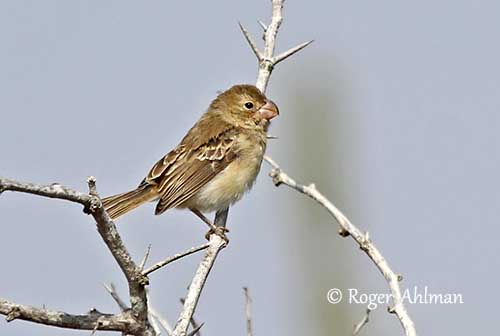
Fr: Sporophile perroquet
Ang: Parrot-billed Seedeater
All: Papageischnabelpfäffchen
Esp: Semillero Peruano
Ita: Beccasemi peruviano
Nd: Papegaaidikbekje
Sd: papegojfröfink
Photographer:
Roger Ahlman
Pbase Galleries Peru and Ecuador
Text by Nicole Bouglouan
Sources:
HANDBOOK OF THE BIRDS OF THE WORLD Vol 16 by Josep del Hoyo- Andrew Elliot-David Christie – Lynx Edicions – ISBN: 9788496553781
BIRDS OF SOUTH AMERICA – Passerines - by Robert S. Ridgely and Guy Tudor – HELM Field Guides – ISBN: 9781408113424
L’ENCYCLOPEDIE MONDIALE DES OISEAUX - Dr Christopher M. Perrins - BORDAS - ISBN: 2040185607
Neotropical Birds – Cornell Lab of Ornithology
Wikipedia, the free encyclopaedia
Wikipedia, la enciclopedia libre
© The Neotropical Ornithological Society
Molecular phylogenetics of the neotropical seedeaters and seed-finches (Sporophila, Oryzoborus and Dolospingus) by Nicholas A. Mason and Kevin J. Burns
Parrot-billed Seedeater
Sporophila peruviana
Passeriformes Order – Thraupidae Family
INTRODUCTION:
The Parrot-billed Seedeater is a South American species present from W Ecuador to SW Peru. It was formerly the only member of the genus Neorhynchus, based on the extremely large bill with very curved culmen, really parrot-like, giving the bird its name. It is now placed in the genus Sporophila in the family Thraupidae.

DESCRIPTION OF THE BIRD:
Biometrics:
Length: 10,5-12,5 cm
Weight: 12-13 g
The adult male of nominate race has greyish-brown upperparts, including the upperwing. We can see a whitish upper wingbar formed by the white tips of the upperwing coverts. A white patch is visible on folded wings, formed by the white bases of primaries. The tail is grey-brown with blackish central pair of rectrices.
On the underparts, throat and breast are black, separated from the grey head by a wide white malar stripe. We can see a white band extending from throat to the neck sides. There is a dark grey breast band on the upper breast. Rest of underparts is white with buffy tinge on flanks.
The head is grey. The peculiar parrot-like bill is yellowish-orange. It is very thick with very rounded culmen and slightly hooked tip. The eyes are dark brown, surrounded by white eyering. Legs and feet are greyish.

The female is duller without conspicuous pattern. She has pale brownish upperparts with pale buff edges to feathers, and dull wings and tail. A small whitish patch appears on folded primaries, but there are two paler wingbars.
The underparts are white with buff wash, whereas the breast is darker, mostly pale buffy-brown. Chin and throat are whitish. The bill is paler, horn-coloured, with darker upper mandible.

The juvenile resembles female.
The non-breeding male has duller foreneck pattern with little or no black.
SUBSPECIES AND RANGE:
The Parrot-billed Seedeater has two subspecies.
S.p. devronis occurs in W Ecuador (from Manabí) S along the coast to NW Peru (Tumbes). This race resembles nominate but it is smaller with slightly smaller bill.
S.p. peruviana occurs on Peruvian coast from La Libertad S to Ica.
HABITAT:
The Parrot-billed Seedeater frequents arid scrub, cultivated and grassy areas, fields, and can be seen near villages. It usually frequents areas where it can find abundant seed sources.
This species occurs from sea-level to 800 metres of elevation, and up to 1400 metres in S Ecuador.

CALLS ANS SONGS: SOUNDS BY XENO-CANTO
The Parrot-billed Seedeater’s call is a descending, wheezy « chew » or « chut”.
The persistent song given during the breeding season is a short, harsh phrase “jew-jee-jew”, or a short series of musical buzzy notes, often introduced with series of rising “djzweet?” notes. The bird sings from hidden perches and changes frequently. While flying, the male utters series of rattles, trills and other buzzy notes.

BEHAVIOUR IN THE WILD:
The Parrot-billed Seedeater feeds on seeds, and especially on grass seeds, but unlike other seedeaters, it forages on the ground.
It usually forages and feeds alone, in pairs or in small groups. However, outside the breeding season, it often occurs in quite large flocks of up to 2000 individuals, especially for drinking at watering holes during the drought.
The Parrot-billed Seedeater probably takes larger and harder seeds than other seedeaters. Like in the Darwin’s Finches, the large, thick, parrot-like bill allows the bird to consume different size of seeds, avoiding competition among the members of the winter flocks.

During the breeding season, the male can be heard singing loudly from several different perches, but it is usually hidden among the vegetation.
This period occurs during the wet season, and the male tends to become more territorial as soon as the first rains start. They are socially monogamous.
The Parrot-billed Seedeater is usually sedentary. Seasonal local movements occur, probably related to seed availability.

REPRODUCTION OF THIS SPECIES:
The breeding season takes place during the wet season, between February and April, and usually starts 15-30 days after the first important rainfalls.
The cup-shaped nest is placed in bush, fairly high above the ground. It is sometimes parasitized by the Shiny Cowbird.
Information is lacking, but usually in these species, the female lays 4-6 eggs. The incubation ranges between 10 and 14 days, probably by the female which has an incubating patch. The chicks fledge between 10 and 15days after hatching.

PROTECTION / THREATS / STATUS:
The Parrot-billed Seedeater is relatively common in its range, but it is patchily distributed.
This species takes advantage from degradation of the habitat for agriculture expansion, creating new areas of suitable habitats.
The population size is unknown, but it is suspected to be increasing, and currently, the Parrot-billed Seedeater is evaluated as Least Concern.
